You’ll need to enable biometric authentication like fingerprint scanning for voice features, update firmware only through encrypted HTTPS connections, and avoid pairing with unsecured Bluetooth networks in public spaces. Create strong 12+ character passwords for linked fitness accounts with two-factor authentication enabled. Disable voice features when not actively needed to reduce your attack surface and extend battery life. Always verify device authentication before processing voice commands and regularly monitor your voice data transmission security settings. These protective measures will help safeguard your personal information from potential threats.
Enable Biometric Authentication for Voice Features
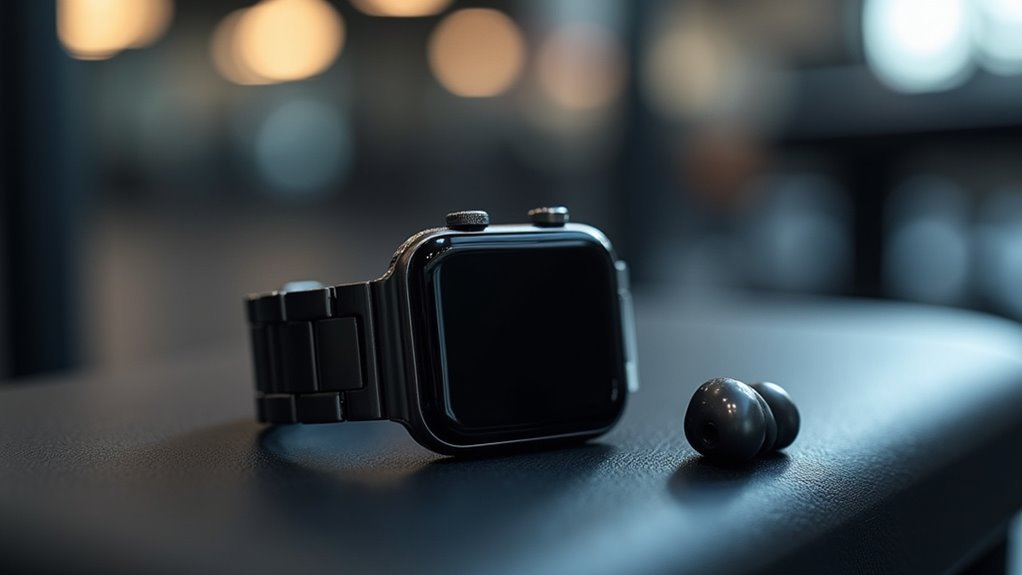
Three key biometric modalities can secure your fitness wearable’s voice features: fingerprint scanning, facial recognition, and voice pattern authentication. Each method captures unique physiological signals through integrated sensors, creating multiple layers of protection for your device.
Voice recognition offers particularly strong security by analyzing your unique vocal characteristics. Advanced speech recognition technology differentiates between users based on voice patterns, making unauthorized access extremely difficult.
You can combine voice authentication with other biometric methods for enhanced multi-factor security.
These biometric systems provide seamless access without manual input, improving your user experience considerably. Your biometric data stays protected through advanced encryption methods, preventing unauthorized access. Behavioral biometrics are gaining popularity because they use non-invasive data collection methods that work continuously in the background.
This personalized authentication also enables tailored health recommendations based on your captured data, creating a more customized fitness experience.
Update Device Firmware Through Encrypted Connections
While biometric authentication protects your device access, keeping your fitness wearable’s firmware updated through encrypted connections forms another critical security layer.
You should only update firmware through secure channels like HTTPS or other encrypted protocols to prevent man-in-the-middle attacks that could compromise your device’s integrity.
When you update through unencrypted connections, attackers can intercept and manipulate firmware during transmission, potentially installing malicious code that accesses your health data.
Always use your device’s official app or platform for updates, which typically employ end-to-end encryption to protect both firmware payload and update commands.
Verify that updates include digital signatures and integrity checks before installation.
This guarantees you’re receiving legitimate firmware from the manufacturer, not tampered versions that could enable unauthorized device control. Regular updates also help protect against the growing number of IoT attacks that specifically target interconnected fitness devices and their communication protocols.
Avoid Pairing With Unsecured Bluetooth Networks
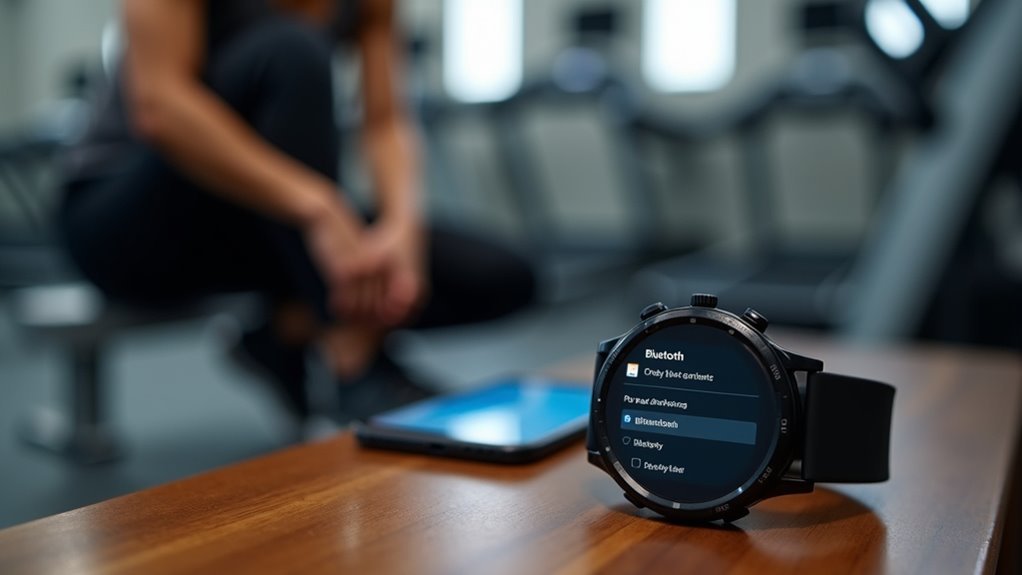
Beyond firmware security, your fitness wearable’s Bluetooth connections present another notable attack vector that requires careful management.
Unsecured Bluetooth networks expose your device to data interception and potential malware injection by attackers within wireless range. When you pair with unknown or insecure devices, you’re risking exposure of sensitive health metrics, location data, and personal information.
You’ll want to disable Bluetooth discoverability when you’re not actively pairing devices, preventing unsolicited connection attempts.
Avoid pairing in public environments where attackers can easily sniff your connection. Always verify device authenticity before establishing connections, and regularly review your paired device list to remove any unfamiliar entries. Many devices still use factory default passwords that haven’t been changed by users, making them easy targets for unauthorized access.
These practices considerably reduce your attack surface and protect your wearable’s data integrity.
Create Strong Passwords for Linked Online Accounts
Your fitness wearable’s voice commands connect to online accounts that need robust password protection to prevent unauthorized access to your health data.
You’ll need passwords with at least 12 characters combining uppercase letters, lowercase letters, numbers, and special symbols to resist brute force attacks.
Create entirely unique passwords for each wearable-linked account since password reuse across platforms makes you vulnerable to credential stuffing attacks that can compromise multiple services simultaneously. Additionally, enable two-factor authentication on all fitness-related accounts to add an extra layer of security beyond just password protection.
Password Complexity Requirements
Since fitness wearables store your most intimate health data—from heart rate patterns to sleep cycles—the passwords protecting your linked accounts become essential gatekeepers to this sensitive information.
You’ll need passwords with at least 15 characters, though longer is better. Instead of complex gibberish like “P@ssword123,” create memorable passphrases such as “Yes, I can run 5 miles today!” This approach naturally includes uppercase letters, numbers, and special characters while remaining easy to remember.
Avoid predictable character substitutions that sacrifice length for complexity. Each additional character exponentially increases your protection against brute force attacks. Your device should allow at least 64 characters, so don’t hesitate to use longer phrases. NIST guidelines no longer require complexity requirements like mandatory uppercase letters or special characters, focusing instead on password length and uniqueness.
Unique Credentials Per Account
One compromised password shouldn’t open your entire digital health ecosystem. Create unique credentials for each fitness wearable account and associated service to prevent credential stuffing attacks.
When hackers steal passwords from one breach, they’ll systematically test those credentials across multiple platforms. You’re particularly vulnerable if you’ve reused passwords between your fitness tracker, companion app, cloud storage, and social media accounts.
Unique passwords contain damage when breaches occur. If someone compromises your fitness app login, they won’t automatically access your email, banking, or other linked services.
This isolation protects sensitive health metrics like heart rate patterns, sleep data, and location tracking. Health data privacy and security threats rival those of financial data, making unique credentials essential protection against data brokers and hackers targeting health information.
Separate credentials for different platforms reduce cascading breaches across your digital ecosystem, keeping your personal health information secure.
Disable Voice Features When Not in Use
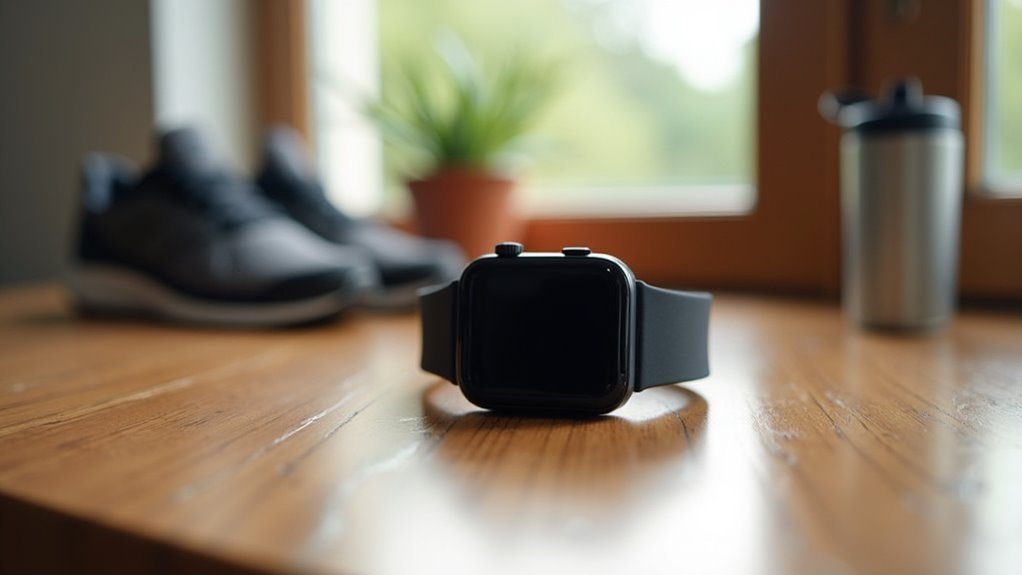
When you’re not actively using voice features on your fitness wearable, disabling them offers three key advantages.
You’ll extend your device’s battery life by reducing power consumption from always-listening microphones and voice processing.
Additionally, you’ll shrink your attack surface against potential security threats while strengthening privacy protection by limiting data collection from ambient conversations.
For Samsung Galaxy devices, you can easily turn off audio guide features through the workout settings menu to eliminate unnecessary voice functionality.
Battery Life Extension
While fitness wearables market impressive battery life claims, voice features can considerably reduce your device’s runtime between charges.
Voice recognition requires continuous microphone activation and energy-intensive algorithms that keep circuits active even during idle periods. Background listening for wake words considerably increases power consumption beyond basic fitness tracking.
You can extend battery life by manually disabling voice assistants through your device’s settings menu. Most wearables allow you to toggle these features, though automatic sleep modes don’t always turn off voice processing. The Amazfit Balance integrates Amazon Alexa for voice assistance, which can be managed through the device settings to optimize power consumption.
Using battery saver modes can provide up to 25 days of use, though with restricted interactive features. User reports suggest disabling voice features can extend battery life by 20-30% per charge, making this a worthwhile consideration for maximizing your wearable’s runtime.
Reduced Attack Surface
Beyond battery conservation, disabling voice features creates significant security benefits by shrinking your wearable’s attack surface.
Voice control features continuously listen for activation keywords, creating persistent vulnerabilities that hackers can exploit. When you leave these features enabled, you’re maintaining constant network communication that provides entry points for unauthorized access.
Disabling voice functionality prevents unauthorized voice commands and potential data interception during transmission. Your device’s network activity footprint shrinks considerably, limiting opportunities for attackers to exploit vulnerabilities.
Many fitness wearables have default settings that auto-enable voice detection, so you’ll need to manually disable these features. Default passwords should also be changed immediately to prevent unauthorized access through commonly known credentials.
This simple action eliminates multiple attack vectors simultaneously: voice command injection, unauthorized remote activation, and continuous data transmission that could be intercepted by malicious actors monitoring your network traffic.
Privacy Protection Enhancement
Although your wearable’s voice features might seem convenient, they’re constantly collecting and transmitting personal data that extends far beyond simple voice commands. You can greatly enhance your privacy by disabling these features when you don’t need them.
Start by turning off audio guides and voice assistants in your device settings. Restrict app permissions to prevent unnecessary data access when voice features aren’t active.
Configure your Samsung Health or Apple Watch to eliminate unwanted voice announcements during workouts. Set your device’s default settings to disable voice features unless you explicitly enable them. Remember that guide frequency settings are exercise-specific, so you’ll need to adjust these privacy controls separately for each workout type you use.
Use silent mode options during specific times or activities. You’ll also want to schedule voice features to activate only when needed, like during designated workout sessions, rather than running continuously throughout your day.
Verify Device Authentication Before Voice Commands
Before your fitness wearable processes any voice command, it must confirm you’re the authorized user through robust device authentication protocols.
Your device should implement OAuth 2.0 and Mobile Auth Token Data Layer Sharing to verify your identity securely.
Enable PPG-based biometric authentication for continuous user verification, as these sensors provide high accuracy without invasive methods.
Guarantee your wearable uses Bluetooth addresses to verify device identities during communication, and activate LE Secure Connections for enhanced pairing security.
Implement multi-factor authentication to add an extra verification layer.
Your device should also utilize behavioral biometrics from fitness data and motion artifact filtering to improve PPG authentication accuracy while maintaining long-term efficacy through adaptive methods. Additionally, check for wrist detection status before displaying sensitive data, as devices may stay unlocked longer when this feature is disabled.
Monitor Voice Data Transmission Security Settings
Since your fitness wearable continuously transmits voice data through Bluetooth connections, you must actively monitor these transmission security settings to prevent unauthorized interception.
Many devices default to public sharing configurations, exposing your voice commands and health data to nearby attackers. You’ll need to regularly review your privacy settings and verify that encrypted protocols safeguard your voice transmissions. Bluetooth connections can create security vulnerabilities that allow hackers to exploit these transmission channels and gain unauthorized access to your personal voice data.
- Enable real-time monitoring alerts for unusual data transmission patterns or unexpected Bluetooth pairing requests that could indicate unauthorized access attempts.
- Review device firmware logs periodically to audit voice data transmission events and identify potential security breaches before they compromise your information.
- Configure cloud storage permissions to restrict voice data access and guarantee strong authentication protects your sensitive health information during transmission.
Frequently Asked Questions
Can Hackers Listen to My Conversations Through Fitness Tracker Voice Features?
Direct hacking to listen through fitness trackers is currently rare. Most don’t continuously record conversations, only capturing voice commands when you activate them. However, if compromised, your active voice interactions could be intercepted.
Which Fitness Wearable Brands Have the Strongest Voice Security Protections?
Apple Watch Ultra 2 and Google Pixel Watch 3 offer you the strongest voice security with biometric authentication, end-to-end encryption, and device-based processing that minimizes cloud exposure risks.
How Do I Know if My Voice Data Is Being Stored?
Check your device settings to see if voice data’s stored locally or synced to cloud services. Review app permissions for microphone access and look for data export options to manage stored recordings.
What Happens to My Voice Recordings if I Switch Devices?
When you switch devices, your voice recordings can usually transfer wirelessly or via cable to your new wearable. However, you’ll lose data if the transfer fails or devices aren’t compatible, so backup recordings beforehand.
Are Voice Commands Safe to Use in Public Spaces?
Voice commands in public spaces aren’t entirely safe. You’re risking data exposure, audio recording by strangers, and interception of sensitive information. Use encryption, lower device volume, and avoid sharing personal details through voice commands.
In Summary
You’ll protect your fitness wearable’s voice features by implementing these security measures consistently. Don’t overlook regular firmware updates and strong authentication methods—they’re your first line of defense. Remember to monitor your device’s data transmission settings and disable voice features when you’re not using them. Stay vigilant about bluetooth connections and account passwords. Your voice data’s security depends on maintaining these practices as part of your routine wearable maintenance.

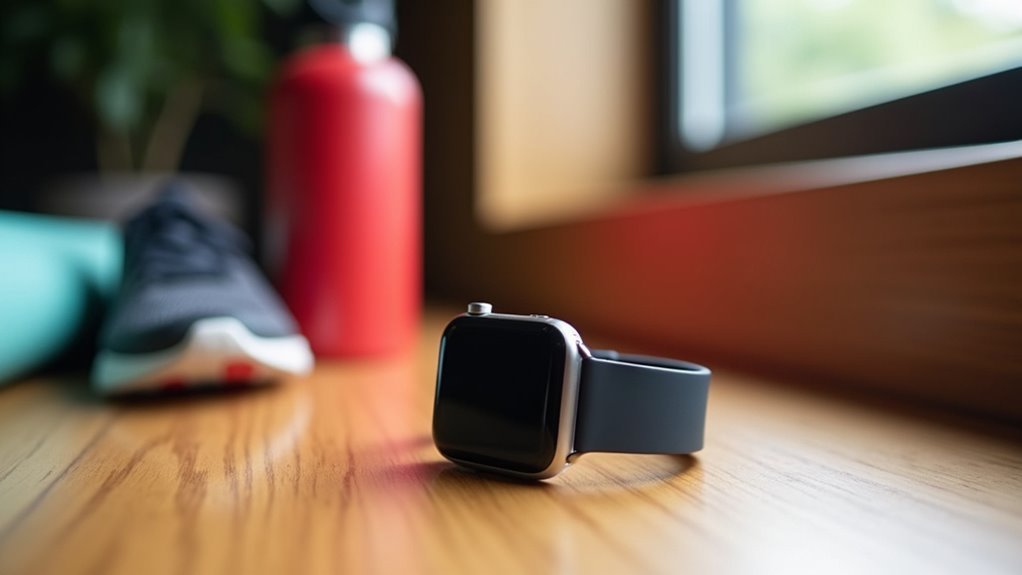

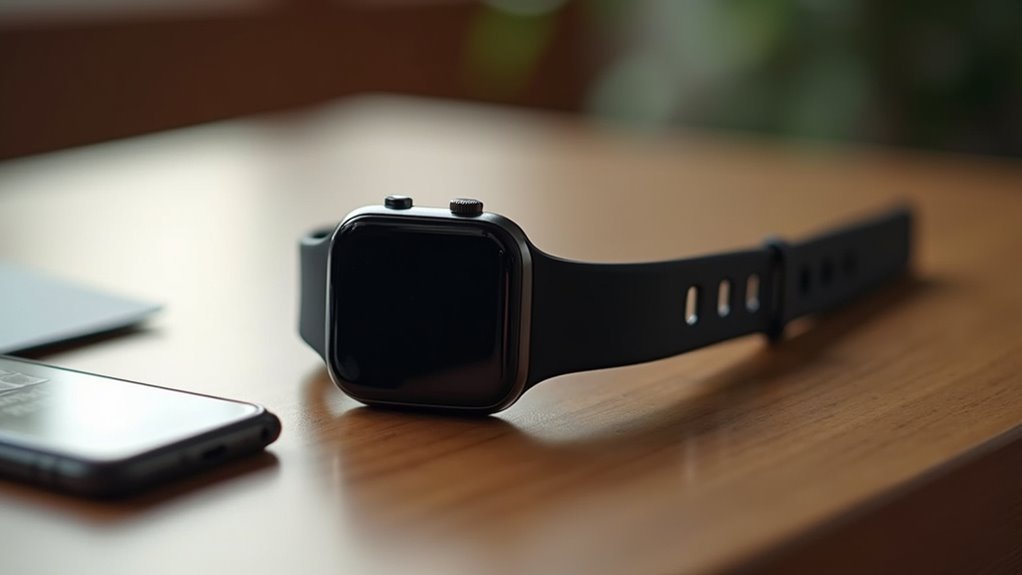
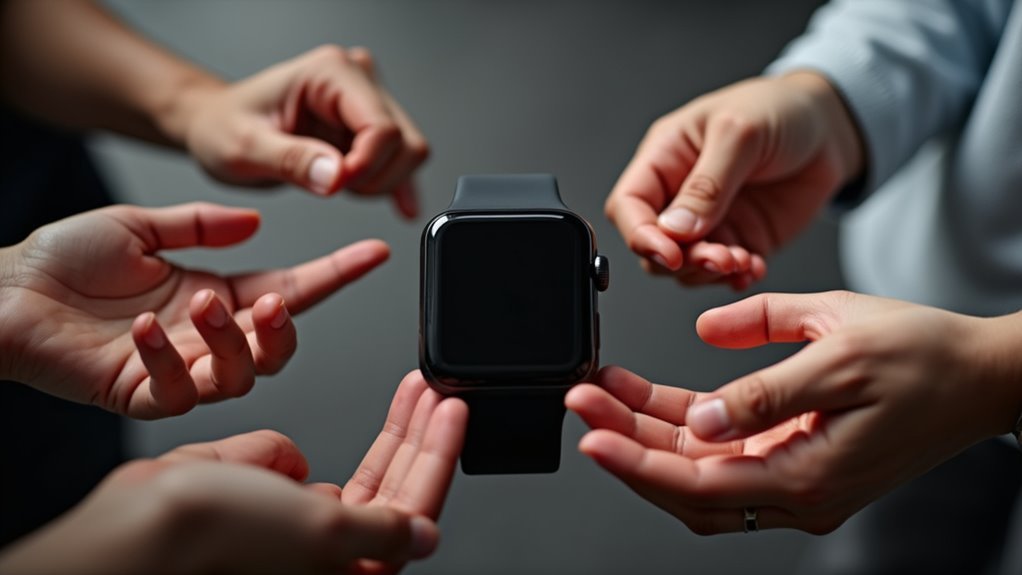
Leave a Reply